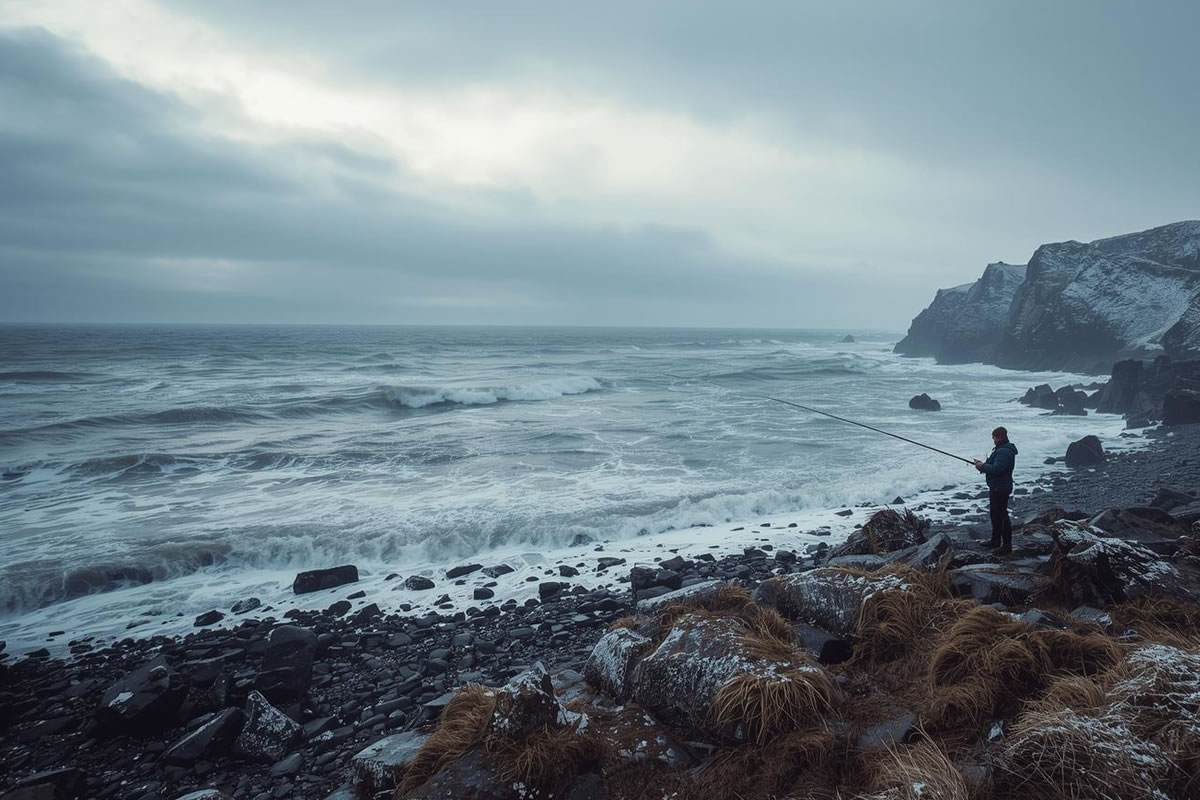
There’s something properly addictive about a cold, clear winter sea session: the bite feels harder-earned, the beaches quieter, and the Bristol Channel can throw up surprisingly good fish when the conditions line up. If you’re based in south-east Wales (Cardiff to Porthcawl and along the Vale of Glamorgan), here are the top shore marks to try in winter, what to expect by species and tide, and practical tips to keep you safe and catching.
1. Lavernock Point – rock ledges and the Ranny Pool
Lavernock is a classic local mark. From rock ledges to the sand and shingle around the point and Ranny Pool, you can expect whiting, dab, bass (occasional in winter), conger and pouting – and when the water’s cold and clear you’ve also got a chance of codlings and the odd ray. It fishes well on an incoming tide when the current sweeps past the point, bringing baits into the deeper gullies. Best tactics: long-ranging ledger rigs or two-rod setups – one short for the close stuff and one long with heavier leads for the deeper runs. Parking and access are easy from the small lane off the B4267.
2. Nash Point & Monknash — ledges for rays, conger and cod
Nash Point and the Monknash ledges are proper rock marks that come into their own when a northerly or easterly swell exposes the ledges. Winter can produce large smooth-hound, blonde and small-eyed rays, conger eels and codling. Fish the edges of the ledges on the flood and early ebb using hooked baits (squid, mackerel strips) on strong traces – there’s kelp and structure, so expect snags and be ready with a trace and weight suitable for abrasion. Note that ledge fishing needs respect for the tide-schedule and footwear for slippery rocks.
3. Porthcawl (Rest Bay, Newton Point, harbour) – versatile beach and point fishing
Porthcawl offers a mix of sandy bays (Rest Bay) and rocky points (Newton/Sker), so it’s a great winter option. Rest Bay produces whiting, dabs and the occasional codling in colder months; the points are better for bass, pollack and conger when conditions allow. When the swell is moderate, you can fish high tide on the beach; when it’s choppy, head to the harbour walls and piers for protection. A mixed approach – surfcasters with big baits and lighter beach rods for close in – works well here.
4. Southerndown – the ledges for cod and bigger fish
Southerndown’s ledges are renowned locally. In winter, you can pick up whiting, codling, conger and rays – and on good nights bigger cod are possible. The mark fishes best on the change of tide; targeting the cuts and gullies with baited ledger rigs is a sensible plan. Because the ground is rocky, use abrasion-resistant traces and heavier leads to hold the bait in strong currents. WorldSeaFishing forum threads and local anglers frequently highlight Southerndown for winter cod and conger sessions.
5. Ogmore-by-Sea & the bridge – sandy beaches with a punch
Ogmore’s beach and the area around the bridge and deeps are good winter sand marks for whiting, dabs, dogfish and occasional bass. When the tide brings in, the deeper channels by the bridge will hold fish; throw out heavier leads and use fresh bait (ragworm, mackerel) for the best results. If you fancy a change, try night sessions when codling and larger whiting move inshore.
6. Barry (Knab Rock, Jackson’s Bay, Bendrick) – sheltered marks with variety
Barry offers sheltered spots that still produce winter bites. Jackson’s Bay and Knab Rock can give whiting, flounder, dogfish and small rays. These are great marks for anglers who prefer shorter walks and easier access – ideal for a quick post-work session. Local videos and trip reports show regular winter sessions producing decent bags when the tide and wind cooperate.
What species to expect in winter
Winter tends to favour the hardier bread-and-butter species: whiting, dabs, flounder, pouting, and dogfish. Conger and codlings can appear when temperatures drop, and rays and smooth-hound are possibilities on the ledges and near estuary mouths. Bass are less predictable but still caught in winter, especially in sheltered estuaries and on calmer days. Overall, adjust tackle to handle small, abrasive fish and occasional big predators.
Tackle, baits and rigs – winter essentials
-
Rods: 12–14ft surf rods for distance; a beachcaster or two for different ranges.
-
Lines/weights: 15–30lb mainline with 30–50lb abrasion-resistant traces on ledges. Use heavier leads (4–8oz or more) into the strong Bristol Channel tides.
-
Rigs: Simple paternosters for dabs/whiting; two-hook flappers or long-shank hooks for rays and larger fish. Use mackerel, squid, lugworm or ragworm depending on the target species.
-
Night sessions: bring a bright headtorch, glow-beads and a safe way to mark your bank.
Safety & tides — don’t get cut off
The Bristol Channel has very large tidal ranges and strong currents. Always check tide times before you go, never fish alone on exposed ledges, wear appropriate footwear and a buoyant jacket on slippery rock marks, and avoid fishing too far down a beach on a rising tide (you can get cut off fast). If in doubt, choose sheltered walls or piers. Local advice and tide tables are essential – plan your session around the safer tide sessions.
Practical tips & etiquette
-
Parking: most marks have nearby roadside parking, but check local signs to avoid restrictions.
-
Litter: take everything home – winter beaches show every piece of rubbish more starkly.
-
Local knowledge: join a regional sea-fishing forum or club for up-to-date marks and special local considerations (some spots fish best at night; others need certain tide states).
-
Licences: Shore fishing for most species doesn’t require an angling licence in the UK, but check local rules for shellfish gathering and any protected zones.
A winter session plan (quick)
Choose a sheltered mark for your first winter trip – Barry or Ogmore are forgiving. Check tide + wind (ideally an onshore wind that smooths the water), pack a long leader, fresh mackerel and ragworm, and aim for the incoming tide into early high. Start with a long cast to the deeper edge; if the bites are light, swap to a short rig and fish the drop-off. Be patient – winter can be slow, but the fish you catch often feel more worth it.
South-east Wales has a surprising variety of shore marks within a short drive: Lavernock’s points and pools, Porthcawl’s bays and points, Nash and Southerndown’s ledges, plus the friendly beaches around Barry and Ogmore. Fish respectfully, check tides, and you’ll find winter sessions that are cold, calm and often very rewarding. Tight lines!




